In 2015 I looked up “Dominican women” on Google Images. Living in the US and repeatedly encountering curious stereotypes around Dominican womanhood when my identity was revealed, often related to ideas of exoticism and expectations of entertainment, I wanted to understand where some of these constructions originated in, and how they circulated.
From fragments of the bodies pictured in the results, I made an installation of around 80 sculptures that hung in space, as well as 25 collages, which I later decided to print as postcards to be dropped surreptitiously at gift shops as I travelled around the Caribbean. In this process, I also started collecting postcards sold at these gift shops and understanding the reciprocity of these constructions, how this monolithic representation is not only an imposed demand from the outside, but also a performance from within. These collected postcards, along with research on various photography archives, are a point of departure for works in this exhibition. The initial Google search still influences some of these works, namely, the bodysuits from the series Containers are sewn to force the wearer to adopt specific poses, which were drawn from the postures seen in the Google results.
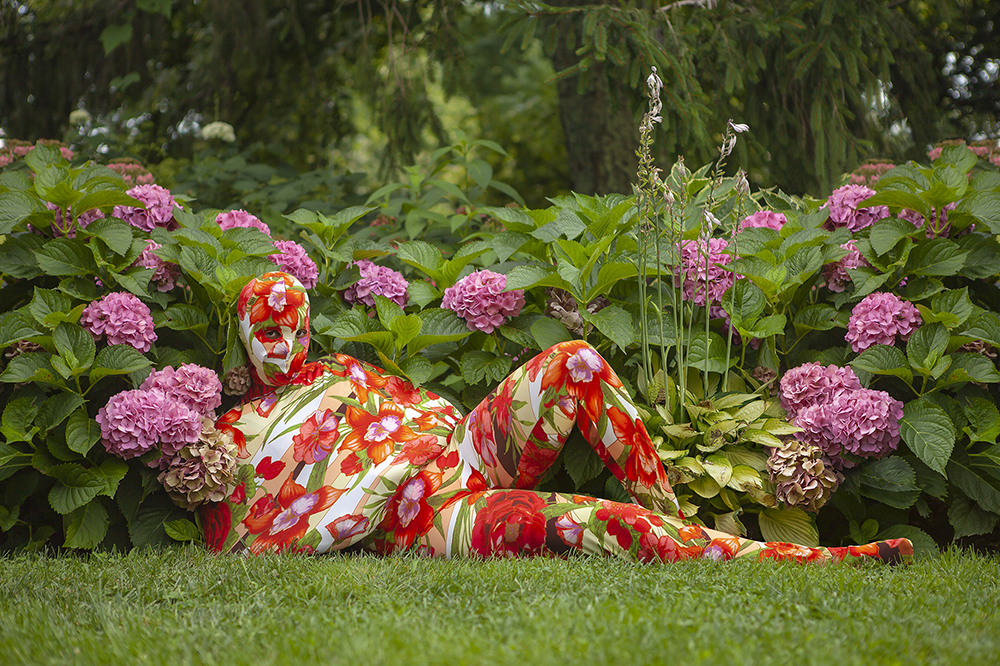
This Container is inspired by a number of Google results from a search for “Dominican women” with similar poses, as well as by art history paintings depicting “odalisques,” reclining female figures, often nudes. One of the most well-known of these paintings is Ingres’ La Grand Odalisque (1814), where, by painting a European woman in an oriental, exotic context, Ingres made her eroticism “acceptable.” This idea was critically examined by Edward Said’s Orientalism (1978) and Linda Nochlin’s The Imaginary Orient (1983) as a cultural strategy of domination, imperialism and power. The odalisquesque figure in Container #4 looks at the viewer, with irony, assertion and somewhat confrontationally, while fully covered in a colorful flower pattern, in front of a garden of hydrangeas enveloping the figure from both sides. The plants in the back are not only highly manicured in real life at Wave Hill, where this image was shot, but are further arranged in photoshop to emphasize the construction.
In Woman-Landscape (on opacity) #4 & #5 I intervene portraits of women used in commercial postcards, from the Dominican Republic (#4) and Jamaica (#5), with textile pattern designs that are deemed tropical. The tropical prints camouflage with the backgrounds in both color and motif, while also concealing the subject. The title “On opacity” points to Glissant’s ideas of Opacity (Poetics of Relation, 1990), a “right” he claimed in relation to identity: to not give into demands of being legible or transparent, instead resisting being “reduced, cornered or amalgamated” by remaining opaque. In these images, the visual tools used to reduce different cultures to a few tropical signifiers are instead employed to shelter the subject from an easy consumption, while also subverting the common pairing of women and landscapes.
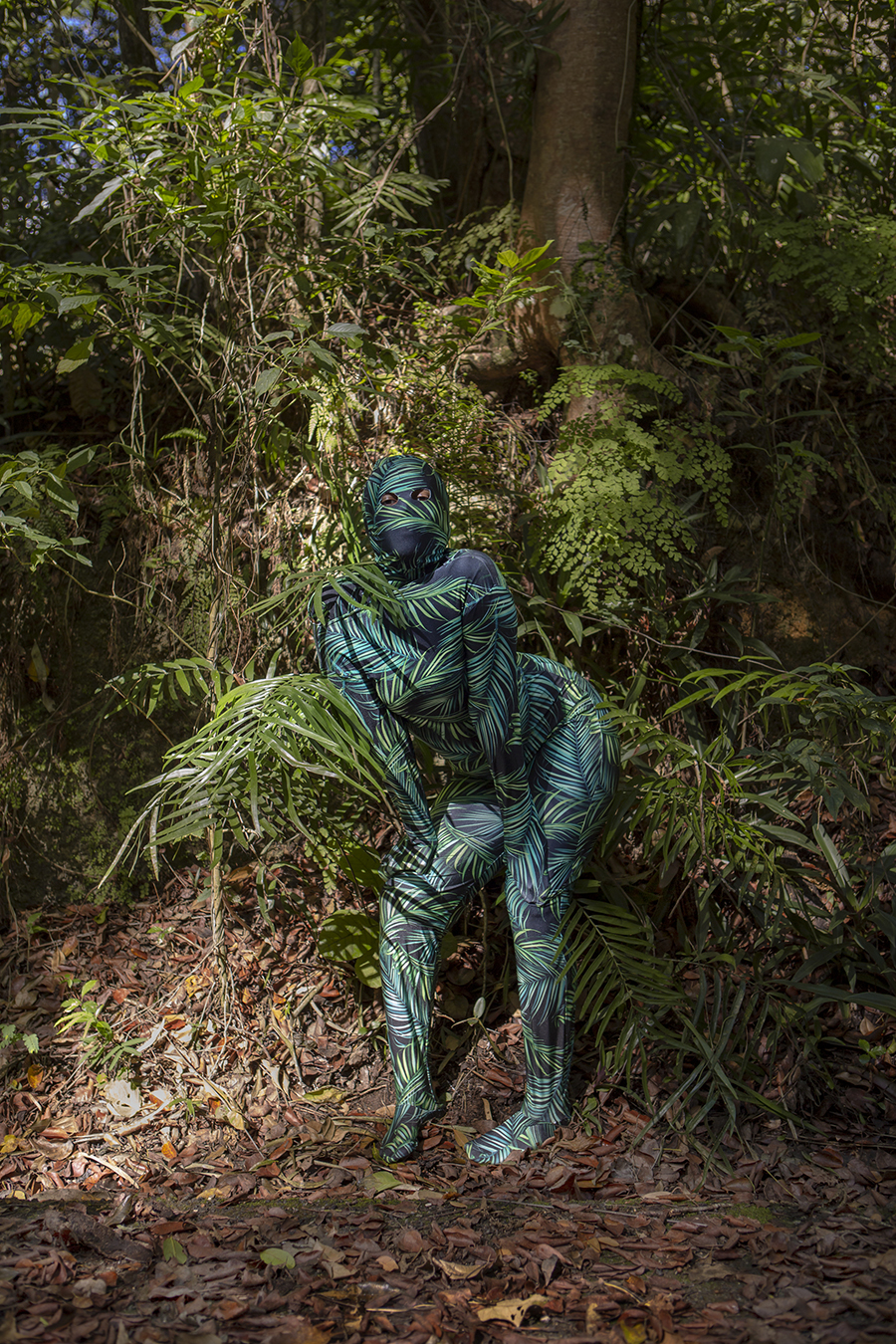
In Container #5, the palm leaf, “jungly”pattern harmonizes with the foliage in the background. This image was taken in one of the least manicured areas of the Botanical Garden of Santo Domingo, evoking a wild setting, although you can still see a bit of the concrete floor where the subject is standing coming through the leaves. The light in the photo, natural sunlight that seems like controlled studio lights, dramatically emphasizes the contrast of construction and nature. With hands sewn to the thighs, this bodysuit forces the wearer to be in this awkward position, kind of standing, but not fully. Yet, the subject looks down upon us, a gaze that is emphasized further in the gallery installation by hanging the photo higher than the rest of the works.
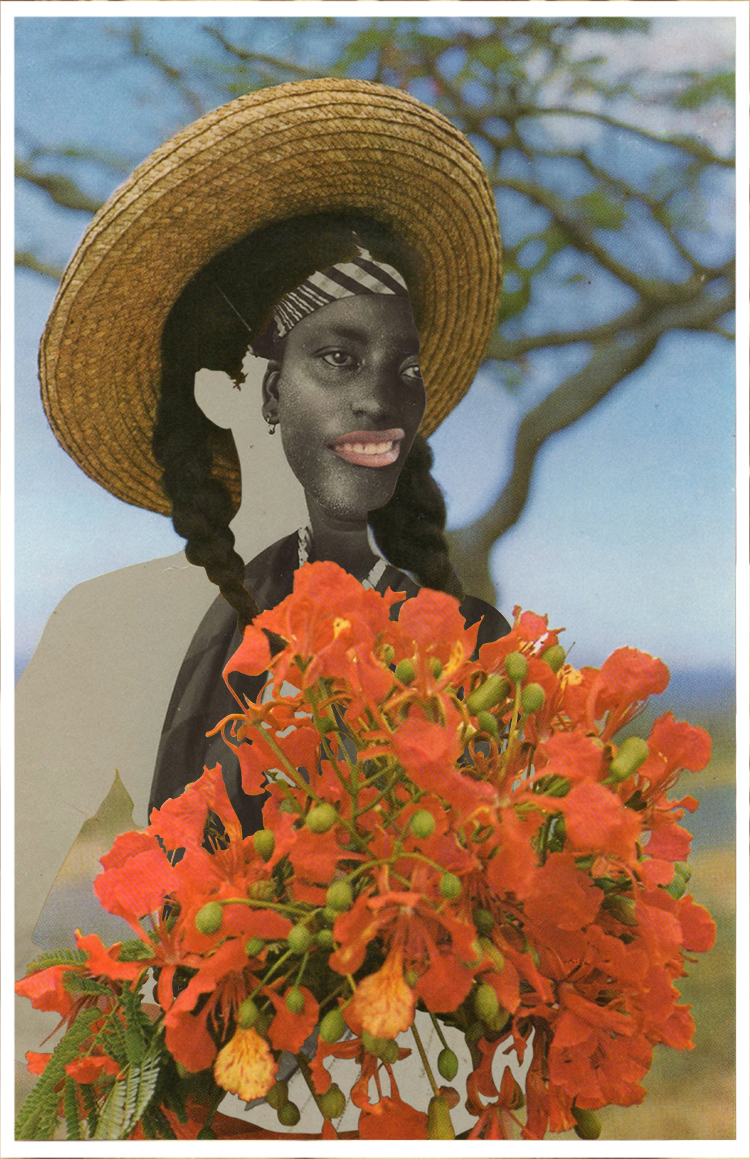
This collage superposes an image of a girl holding poinciana flowers from a 70’s Martinique postcard. Through the cutout of the top image, a woman underneath looking at us directly is revealed. That image was also taken in Martinique circa 1870-1880 by Gaston Fabre, who often turned his subjects into photographic “ethnic types”, an exploration in between ethnography, anthropology and souvenir tourism. Ayoowiri is the indigenous name of a plant (caesalpinia pulcherrima) whose flowers look a lot like poinciana flowers (delonix regia), a picturesque, decorative tree abundant throughout the Caribbean and often represented in touristic media. But these two are entirely different plants. Ayoowiri, also known as peacock flower, is both a medicinal plant and a poison, known for having been used as abortifacient in Surinam by enslaved women wanting to rid their offspring from their fate of being born into slavery. The begrudged smile resulting from the juxtaposition of the two images makes me think of how ayoowiris look like poincianas.
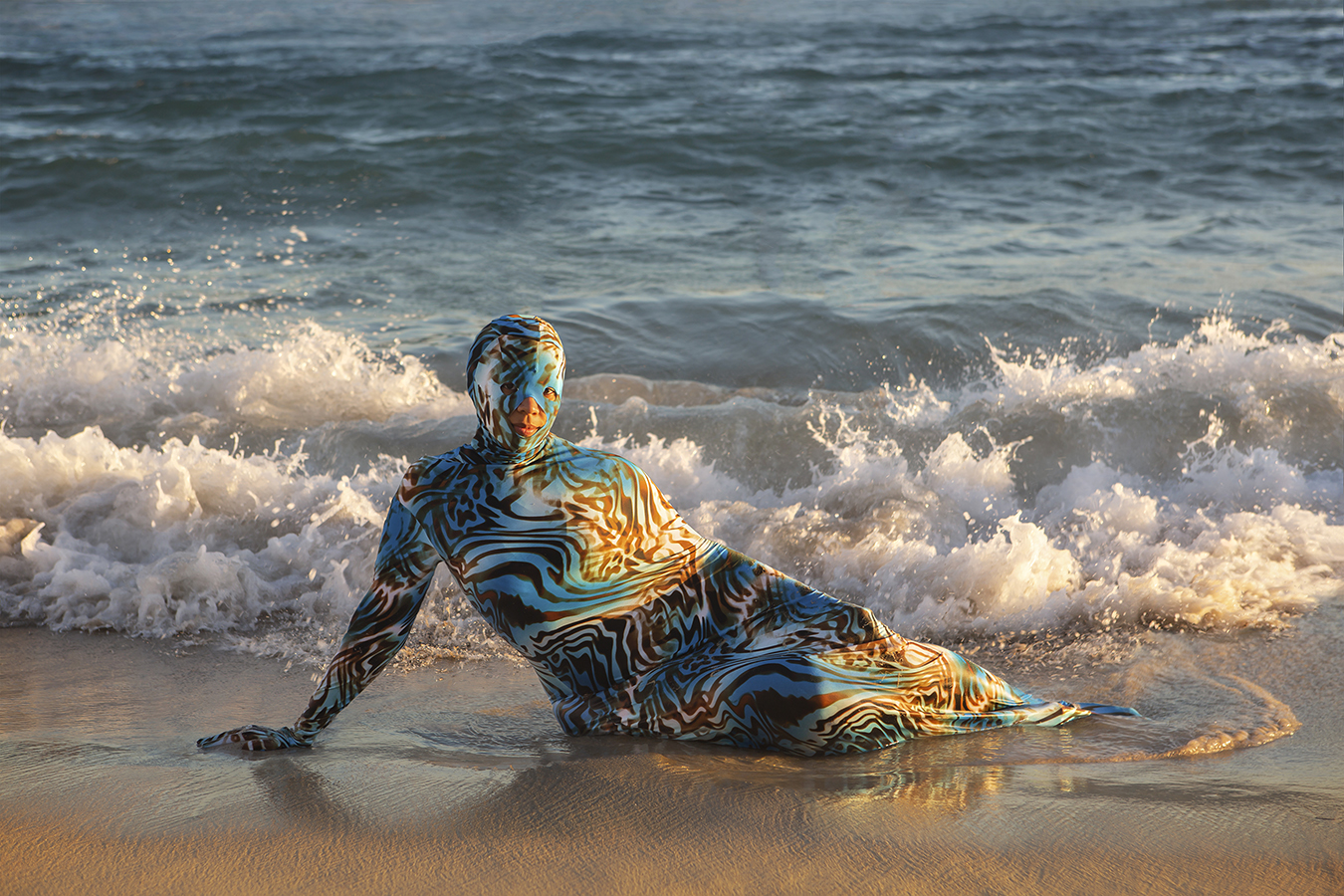
In this image, the subject lies on her side at a beach while waves break in splashes behind her. One her right hand is her only independent limb, supporting the weight of her reclining posture while her other hand, along with both legs are inside a sort of sac, enveloping most of her body into a siren shape. Like Body of water, this bodysuit features a more abstracted pattern than the rest used in other works, reminiscent of some kind of water-animal print, which along with the shape of the bodysuit perhaps makes the figure more creature-esque than the rest of the Containers. However, this is the only bodysuit where the mouth of the subject can be seen, softly smiling, which in turn also humanizes the subject more than the others. This photo was taken in one of the several Dominican beaches that have been through a “beach regeneration” process, where sand is added to the beach to replace sand lost due to erosion or as a side effect of growing unregulated tourism infrastructure.


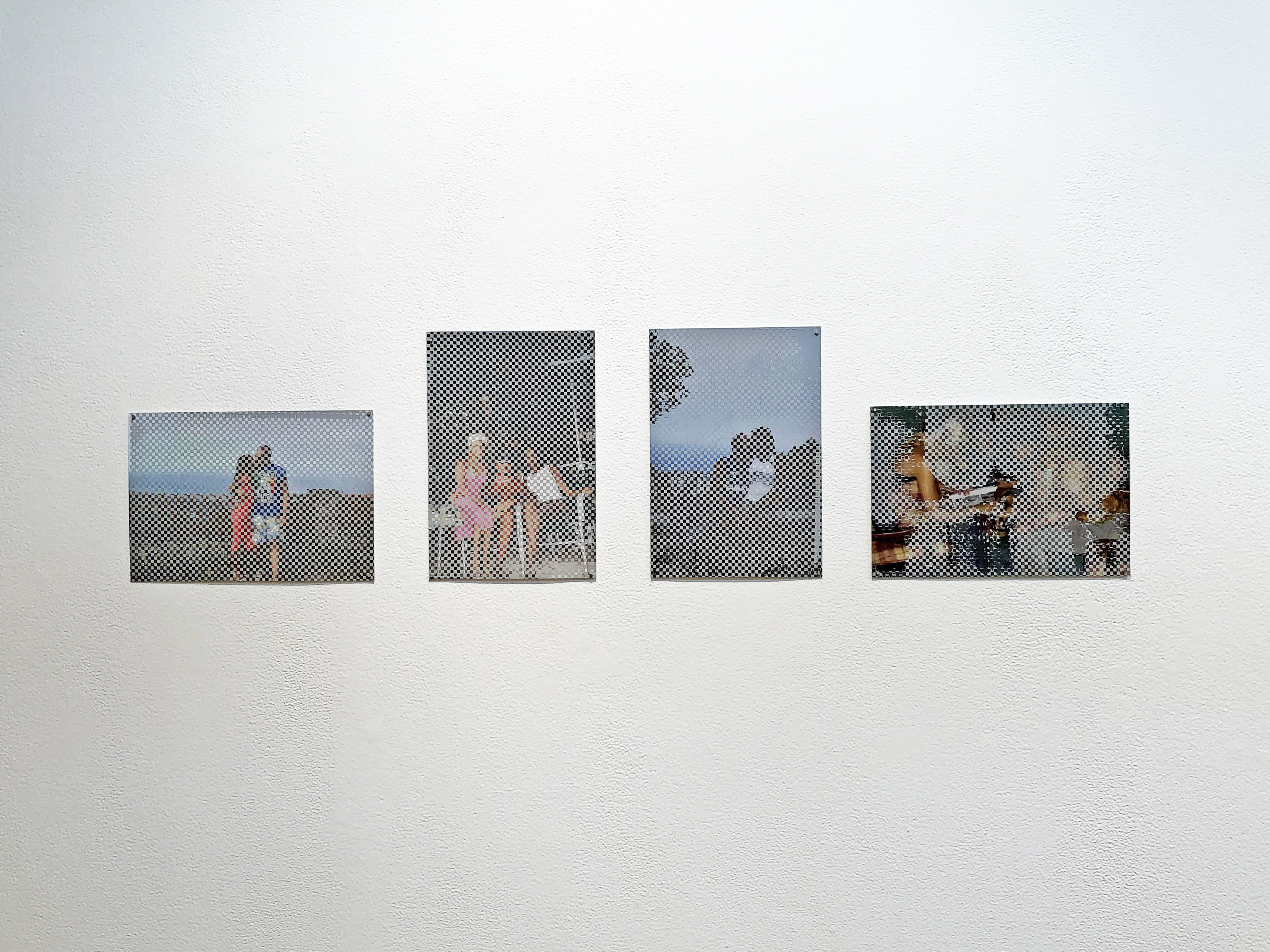
Postcard composition #1 & #2 are postcards I bought, scanned and digitally intervened. Some of the panels have been changed, but the formulaic pairing of a woman’s face or body and the snippets of landscapes have been maintained, along with other graphic choices, like the “drop shadow” effect on the panels. The bodies of women are obscured by the gray and white design used in photoshop called “transparency” layer, which here points to the interchangeability of these subjects within these formulaic compositions, while at the same time denying visibility to the assumed consumer of these images.
The nearby works Veil #1, #2, #3, #4 depart from images taken from websites that act as online catalogs for men who want to date a Dominican woman while on vacation there. They tend to have some sort of “testimonials” section where these men post images of women they dated while recounting the events of their dates. In these works, the transparency layer design is silkscreened on top of the original images, only using the gray color of the originally gray and white checker pattern, acting as a veil as you’re able to see parts of the images coming through the parts that are uncovered.

In the original scanned section of a vintage postcard advertising the Dominican Republic, you can see the face, upper torso and shoulders of a woman leaning back and floating on the water surface. In this collage, the woman has been replaced by an abstract print from a piece of fabric I bought. While collecting samples of commercially available “tropical prints” I’ve encountered a few of these more abstract and nuanced designs that are still classified under “tropical print.” by the stores that sell them, like this one that kind of looks like water but also animal print. Although still somewhat stereotypical, designs like these are more open ended. The way the juxtaposed elements operate in this collage makes me think of dazzle camouflage, a type of design briefly used on military ships in the 1910s-1920s to make it difficult to tell their size, direction and speed when seen from afar, with the intention of making them misleading as opposed to concealing them, like a strategically confusing hypervisibilty.

In Tropical transparencies, the same replacement of women’s image with photoshop’s iconic “transparency” background design used in Postcard composition #1 & #2 is done to the four women posing together facing the camera, in a photo extracted from a website that actually features Asian women, not Dominican ones. Once the bodies are obscured, the other elements of the photo (the interior of a bar background, the palm trees and flowers on the fabric prints of their dresses) could be anywhere: imperial narratives have made the “tropical” a kind of universal ready-made that is decorative, interchangeable, disposable.

Continuum is a digital collage with two images. The background image was taken by Roland Bonaparte, who photographed a number of people brought to Europe and the US to be studied by anthropologists and be exhibited in zoological gardens as specimens in reconstructed native villages. The photo on top of it is an image result from the google search for “Dominican women”. I was interested in the continuity of the pose, and the action of posing for somebody in this manner, which is somewhat unnatural and performative, trying to map this performativity through a visual genealogy of sorts. I’m also interested by how both image are framed by nature, which in both cases is artificially constructed, meaning, the plants are real but the space is constructed and maintained to emulate certain ideas of tropicality and exoticism. “The photograph validates the existence of a type, even if that type is entirely constructed by the photographer.” (Deborah Willis and Carla Williams, The Black Female Body in Photographs from World’s Fairs and Expositions, published in Exposure, Volume 33. 1/2. Williams and Willis discuss the images Bonaparte took in their year 2000 essay).
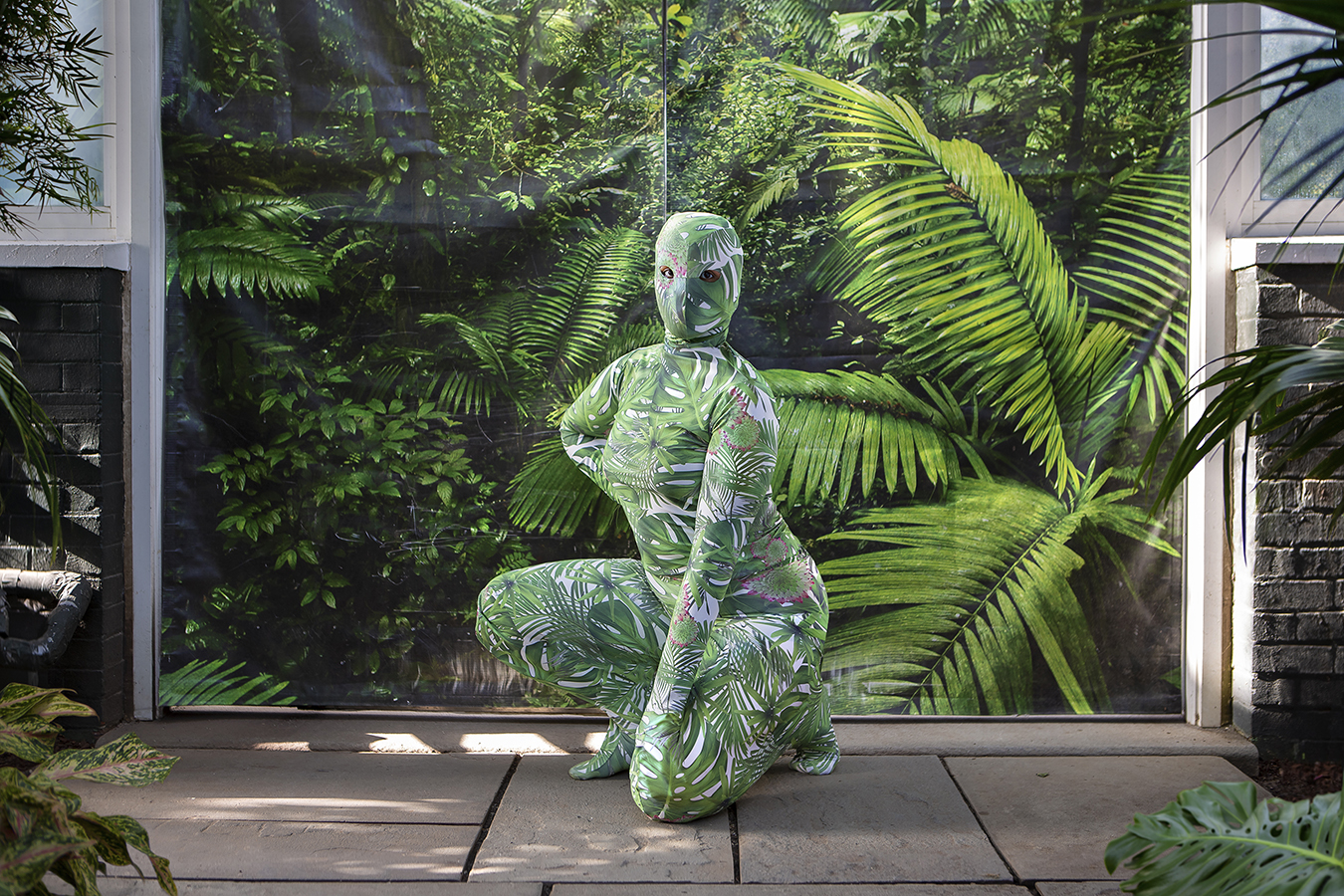
This series' latest photo, Container #7 continues my interest in the relationship between the posing gendered body, the framed, constructed landscape and the commodification of nature, essentialized into commercial pattern design. This is the first time I incorporate a photo background (found on site) further pushing this dialogue. The picture was taken at the greenhouses at the NYBG, a contentious site to me because of what it represents: echoes of colonial botanical gardens that were once human zoos where black and indigenous women were photographed in dehumanizing ways; nuanced decolonial ethnobotanical research interested in the knowledge of black and indigenous women; preservation of said knowledge while also denying access of that knowledge to the immediate community in its surroundings with prohibitive entry fees; a place of solace where I can recognize plants I grew up with; a dislocation of said plants reminding of my own dislocation.